Oracle Bundle
Can Oracle Maintain Its Dominance in the Tech Titans' Turf War?
Oracle, a titan in enterprise technology, is locked in a fierce battle for market share. Its evolution from a database pioneer to a cloud computing contender has redefined the competitive arena. Understanding Oracle's position requires a deep dive into its rivals, strategies, and the ever-shifting dynamics of the Oracle SWOT Analysis.
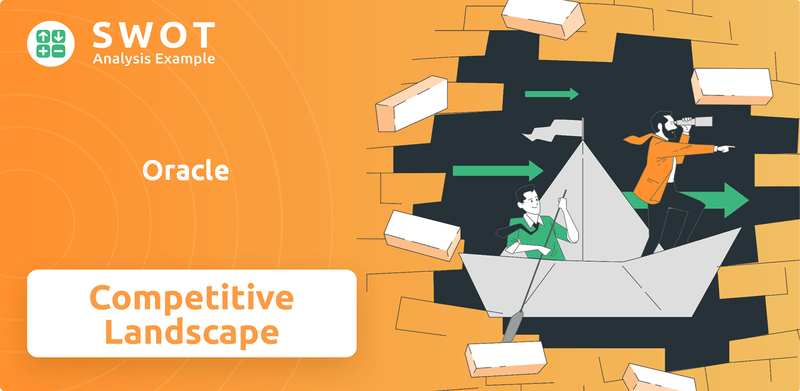
This analysis will dissect the Oracle competitive landscape, examining its Oracle market position amidst fierce competition. We'll explore who the Oracle competitors are, focusing on key players in the Oracle cloud competitors space and the broader Oracle software market. Furthermore, we'll conduct an Oracle industry analysis to understand the challenges and opportunities shaping its future, providing actionable insights for investors and strategists alike.
Where Does Oracle’ Stand in the Current Market?
Oracle holds a significant market position, especially in enterprise software and cloud computing. The company's standing varies across different segments, but it consistently ranks among the top performers in the database management system (DBMS) market. Analyzing the Oracle market position reveals a strong global presence and a diverse customer base that includes businesses of all sizes and government agencies.
Oracle's core offerings include its database software, Oracle Cloud Infrastructure (OCI), and a suite of enterprise applications. These applications cover areas like Enterprise Resource Planning (ERP), Human Capital Management (HCM), and Supply Chain Management (SCM) through its Fusion Cloud Applications. The company has been strategically shifting its focus towards cloud services, aiming to transition its existing customer base and attract new clients.
Financially, Oracle demonstrates considerable scale. For the third quarter of fiscal year 2024, which ended February 29, 2024, Oracle reported total quarterly revenues of $13.3 billion, marking a 7% year-over-year increase. Cloud revenue (IaaS plus SaaS) for the same quarter was $5.1 billion, reflecting a 25% rise. These figures highlight Oracle's financial health and strategic investments in OCI and AI capabilities, positioning it as a formidable player in the industry. The Oracle competitive landscape is dynamic, with the company actively working to strengthen its position in the public cloud infrastructure market.
Oracle has historically led the database management system (DBMS) market. Even with the rise of cloud-native databases, Oracle remains a top performer. In 2023, Oracle maintained its leadership in the operational database management systems market.
Oracle is aggressively pivoting towards cloud services to transform its business. This strategic shift aims to move its vast on-premise customer base to cloud offerings. The goal is to attract new cloud-native clients and strengthen its market position.
Oracle's financial results for Q3 FY24 show robust growth. Total quarterly revenues reached $13.3 billion, up 7% year-over-year. Cloud revenue (IaaS plus SaaS) increased significantly, reaching $5.1 billion, a 25% increase, demonstrating strong performance.
Oracle serves a diverse global customer base. Its customers range from small and medium-sized businesses to large multinational corporations and government agencies. This broad reach supports its overall market position.
Oracle's market position is shaped by several key factors. The company's database technology, cloud services, and enterprise applications are central to its strategy. Understanding the Oracle competitive landscape involves analyzing these areas.
- Database Leadership: Oracle's strong presence in the DBMS market remains a key strength.
- Cloud Expansion: The shift towards cloud services is a critical strategic move.
- Financial Strength: Consistent revenue growth supports investments and market competitiveness.
- Global Reach: A diverse customer base across various industries enhances market stability.
Oracle SWOT Analysis
- Complete SWOT Breakdown
- Fully Customizable
- Editable in Excel & Word
- Professional Formatting
- Investor-Ready Format
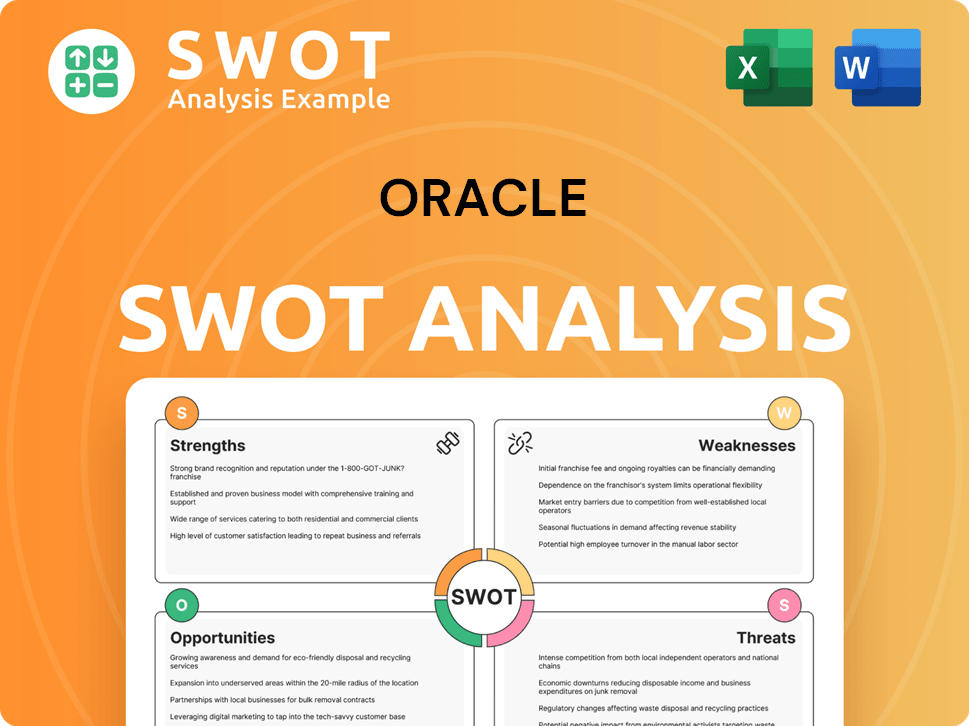
Who Are the Main Competitors Challenging Oracle?
Understanding the Oracle competitive landscape is crucial for anyone analyzing the technology sector. The company faces intense competition across its diverse business segments, from cloud infrastructure to enterprise applications. This analysis helps to understand the market dynamics and Oracle's market position.
The Oracle industry analysis reveals a constantly evolving environment shaped by technological advancements, mergers, and acquisitions. Staying informed about Oracle competitors and their strategies is essential for making informed decisions. For a deeper dive into the company's financial structure, consider exploring Revenue Streams & Business Model of Oracle.
In cloud infrastructure, Oracle Cloud Infrastructure (OCI) competes directly with major players like Amazon Web Services (AWS), Microsoft Azure, and Google Cloud. AWS holds a significant market share, offering a wide array of services. Microsoft Azure leverages its enterprise customer base, and Google Cloud is rapidly expanding its capabilities.
In the enterprise application software space, Oracle competes with SAP, Salesforce, Workday, and Infor. SAP is a strong rival in ERP and supply chain management. Salesforce dominates the CRM market, and Workday specializes in cloud-based HCM and financial management software.
Oracle faces indirect competition from open-source alternatives in the database market. PostgreSQL and MySQL are notable examples. Specialized software vendors offering niche solutions also contribute to the competitive pressure.
The competitive landscape is affected by mergers and alliances. For instance, Microsoft's acquisition of Nuance Communications and various AI startups strengthens its position. These strategic moves impact the overall market dynamics.
Emerging players focusing on specific cloud services or industry verticals consistently disrupt the traditional landscape. These companies require Oracle to remain agile and innovative to defend its market share and pursue new growth opportunities.
To compete effectively, Oracle must focus on innovation, strategic partnerships, and customer-centric solutions. The company's ability to adapt to changing market demands will determine its future success. It is essential to evaluate Oracle's strengths and weaknesses.
A detailed analysis of Oracle's competitive landscape involves assessing each competitor's strengths, weaknesses, and market strategies. This includes understanding their product offerings, pricing models, and customer base. It is also important to evaluate Oracle's competitive advantages in database technology and its ability to compete in the Oracle software market.
- AWS: Dominates the cloud infrastructure market with a broad service portfolio. AWS's market share in the cloud infrastructure market was around 32% in Q4 2024.
- Microsoft Azure: Leverages its enterprise customer base and hybrid cloud offerings. Microsoft Azure's market share in the cloud infrastructure market was around 25% in Q4 2024.
- SAP: A major player in ERP and supply chain management. SAP reported cloud revenue growth of 24% in 2024.
- Salesforce: The leader in CRM, constantly innovating its cloud-based offerings. Salesforce's revenue for fiscal year 2024 was $34.5 billion.
- Google Cloud: Rapidly expanding its capabilities in data analytics and AI. Google Cloud's revenue grew by 28% in Q4 2024.
Oracle PESTLE Analysis
- Covers All 6 PESTLE Categories
- No Research Needed – Save Hours of Work
- Built by Experts, Trusted by Consultants
- Instant Download, Ready to Use
- 100% Editable, Fully Customizable
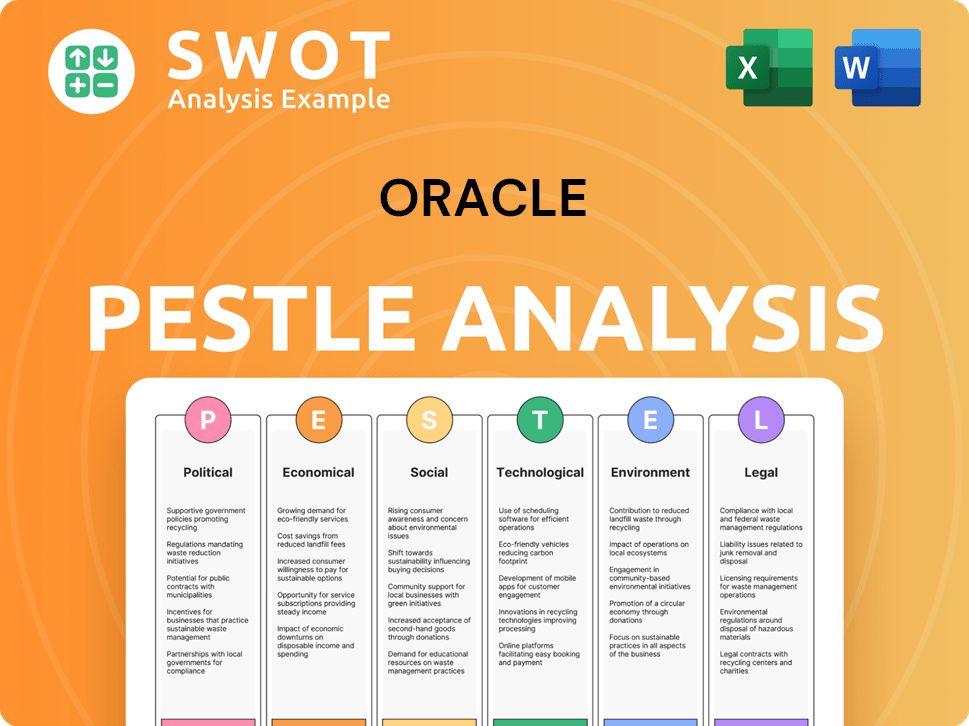
What Gives Oracle a Competitive Edge Over Its Rivals?
Understanding the competitive landscape of Oracle requires a deep dive into its core strengths and how it differentiates itself from rivals. Oracle's position in the software market is shaped by its proprietary technologies, brand recognition, and extensive customer base. The company's strategy involves continuous innovation and strategic acquisitions to maintain its competitive edge.
Oracle's competitive advantages are multifaceted, ranging from its robust database technology to its strong brand equity. These advantages are crucial for understanding its market position and how it navigates the challenges posed by competitors. Examining these elements provides insights into Oracle's ability to maintain its leadership in the enterprise software sector.
The company's financial performance, compared to its competitors, reflects the impact of its strategic decisions and market dynamics. Analyzing these aspects helps to assess Oracle's long-term sustainability and its ability to adapt to changes in the tech industry.
Oracle's core strength lies in its proprietary database technology, considered an industry standard for enterprise applications. The company continuously integrates AI capabilities into its database and cloud applications, enhancing its competitive edge. This focus on innovation helps Oracle stay ahead of rivals in the software market.
Oracle has built a globally recognized brand synonymous with enterprise-grade software, fostering trust among large enterprises. This strong brand recognition translates into deep customer loyalty, as migrating from Oracle's integrated systems can be complex. Oracle's brand equity is a key differentiator in the Oracle competitive landscape.
Oracle leverages economies of scale in its cloud infrastructure (OCI) and enterprise applications, offering competitive pricing and comprehensive services. The company's extensive distribution networks and skilled talent pool support its complex solutions globally. This global reach is crucial for maintaining its market position.
Strategic acquisitions, such as the recent acquisition of Cerner, extend Oracle's reach into specialized markets like healthcare. These acquisitions add new intellectual property and customer bases, strengthening its overall competitive position. This strategy is essential for adapting to changes in the tech industry.
Oracle's key differentiators include its robust database technology, strong brand equity, and extensive customer base. The company faces challenges from competitors like AWS, Microsoft, and SAP. Oracle's strategy involves continuous investment in innovation and strategic partnerships to maintain its competitive edge.
- Database Technology: Oracle's database remains a core strength, offering reliability, scalability, and security.
- Cloud Infrastructure: Oracle Cloud Infrastructure (OCI) competes with AWS and Azure, focusing on performance and cost-effectiveness.
- Enterprise Applications: Oracle's ERP and CRM solutions compete with SAP and Salesforce, respectively.
- Strategic Acquisitions: Acquisitions like Cerner expand Oracle's market reach and product offerings.
Oracle's competitive landscape is dynamic, with continuous shifts in market share and technological advancements. The company's ability to adapt to these changes will determine its future in the enterprise software sector. To learn more about how Oracle strategizes for growth, consider reading about the Growth Strategy of Oracle.
Oracle Business Model Canvas
- Complete 9-Block Business Model Canvas
- Effortlessly Communicate Your Business Strategy
- Investor-Ready BMC Format
- 100% Editable and Customizable
- Clear and Structured Layout
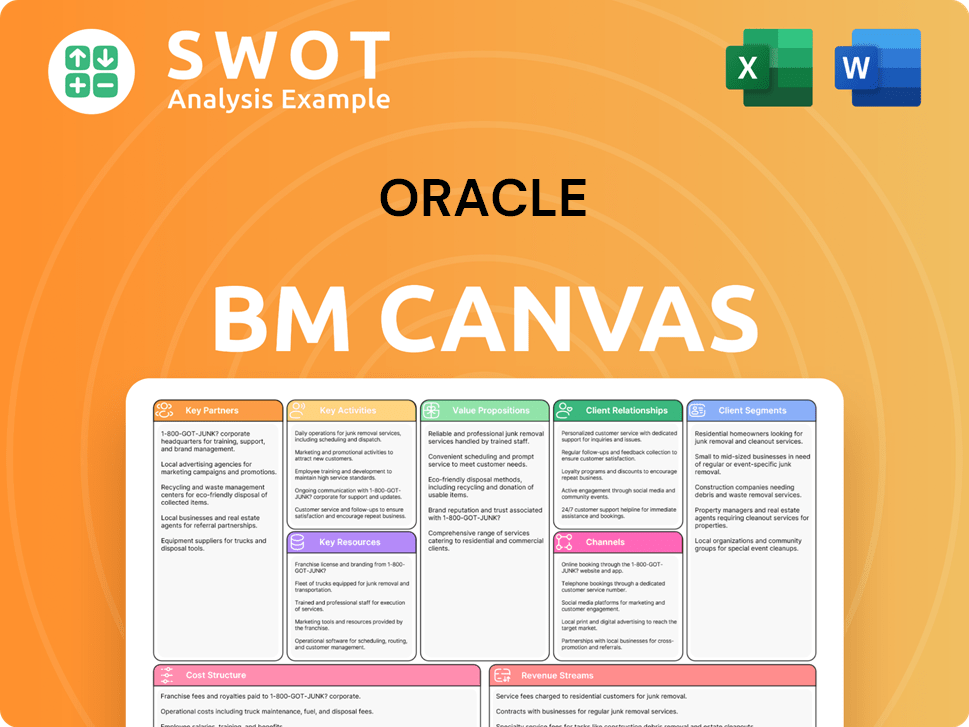
What Industry Trends Are Reshaping Oracle’s Competitive Landscape?
The enterprise software and cloud computing industries are experiencing rapid transformation, significantly impacting the competitive landscape for companies like Oracle. The ongoing shift towards cloud computing, the integration of artificial intelligence (AI), and evolving regulatory environments are key industry trends. Understanding these trends is crucial for evaluating Oracle's market position and future prospects.
Oracle faces both challenges and opportunities. Increased competition from hyperscale cloud providers and niche Software-as-a-Service (SaaS) vendors, along with the need to comply with data privacy regulations, are significant hurdles. However, Oracle's focus on industry-specific cloud solutions, hybrid cloud strategies, and its strong database expertise provide avenues for growth and maintaining a competitive edge. For a deeper dive into the company's approach, you can explore the Marketing Strategy of Oracle.
The primary industry trend is the accelerated adoption of cloud computing. Enterprises are increasingly migrating from on-premise solutions to cloud-native architectures. AI and machine learning are also significantly impacting enterprise technology, driving automation and enhancing data analytics. Regulatory changes, particularly regarding data privacy and sovereignty, are also shaping the market.
Key challenges include heightened competition from major cloud providers and niche SaaS vendors. Regulatory compliance, especially concerning data privacy, requires ongoing investment. Geopolitical shifts and economic uncertainties can also impact IT spending, affecting revenue. Continuous innovation and differentiation are essential to maintain a competitive position.
Growing demand for industry-specific cloud solutions, particularly in healthcare, presents a significant opportunity. Hybrid cloud and multi-cloud strategies also favor Oracle, as OCI is designed to be compatible with various environments. The strong global demand for secure and high-performance database solutions continues to be a key strength.
Oracle's strategy focuses on integrating AI across its product portfolio, enhancing vertical cloud offerings, and expanding its global data center footprint. These initiatives aim to strengthen its competitive position and capitalize on evolving industry dynamics. The company is investing heavily in its cloud infrastructure and applications.
Oracle's competitive landscape is shaped by its ability to innovate and adapt to market changes. The company’s market position depends on its technological advancements, strategic partnerships, and customer satisfaction. Oracle's ability to compete with major cloud providers like AWS, Microsoft Azure, and Google Cloud is crucial.
- Cloud Infrastructure: Oracle Cloud Infrastructure (OCI) competes with AWS, Azure, and Google Cloud.
- Database Technology: Oracle's database solutions compete with offerings from Microsoft, IBM, and open-source databases.
- Enterprise Applications: Oracle's Fusion Cloud Applications compete with SAP, Workday, and Salesforce.
- Industry-Specific Solutions: Oracle's vertical solutions compete with specialized vendors in healthcare, finance, and other sectors.
Oracle Porter's Five Forces Analysis
- Covers All 5 Competitive Forces in Detail
- Structured for Consultants, Students, and Founders
- 100% Editable in Microsoft Word & Excel
- Instant Digital Download – Use Immediately
- Compatible with Mac & PC – Fully Unlocked
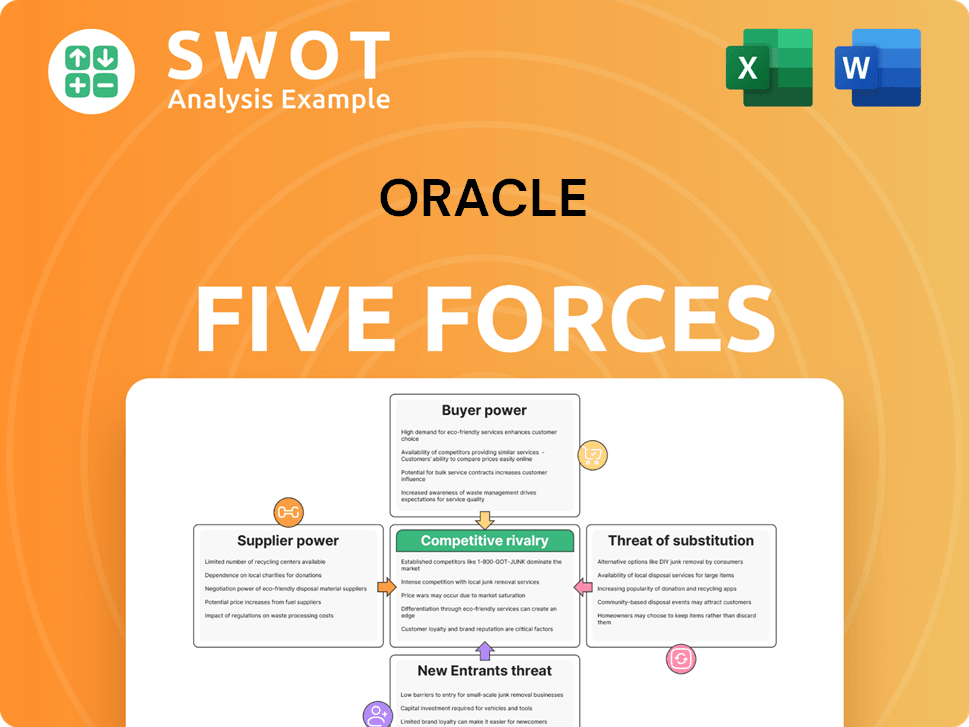
Related Blogs
- What are Mission Vision & Core Values of Oracle Company?
- What is Growth Strategy and Future Prospects of Oracle Company?
- How Does Oracle Company Work?
- What is Sales and Marketing Strategy of Oracle Company?
- What is Brief History of Oracle Company?
- Who Owns Oracle Company?
- What is Customer Demographics and Target Market of Oracle Company?
Disclaimer
All information, articles, and product details provided on this website are for general informational and educational purposes only. We do not claim any ownership over, nor do we intend to infringe upon, any trademarks, copyrights, logos, brand names, or other intellectual property mentioned or depicted on this site. Such intellectual property remains the property of its respective owners, and any references here are made solely for identification or informational purposes, without implying any affiliation, endorsement, or partnership.
We make no representations or warranties, express or implied, regarding the accuracy, completeness, or suitability of any content or products presented. Nothing on this website should be construed as legal, tax, investment, financial, medical, or other professional advice. In addition, no part of this site—including articles or product references—constitutes a solicitation, recommendation, endorsement, advertisement, or offer to buy or sell any securities, franchises, or other financial instruments, particularly in jurisdictions where such activity would be unlawful.
All content is of a general nature and may not address the specific circumstances of any individual or entity. It is not a substitute for professional advice or services. Any actions you take based on the information provided here are strictly at your own risk. You accept full responsibility for any decisions or outcomes arising from your use of this website and agree to release us from any liability in connection with your use of, or reliance upon, the content or products found herein.